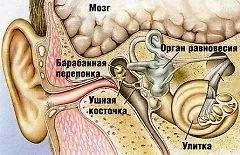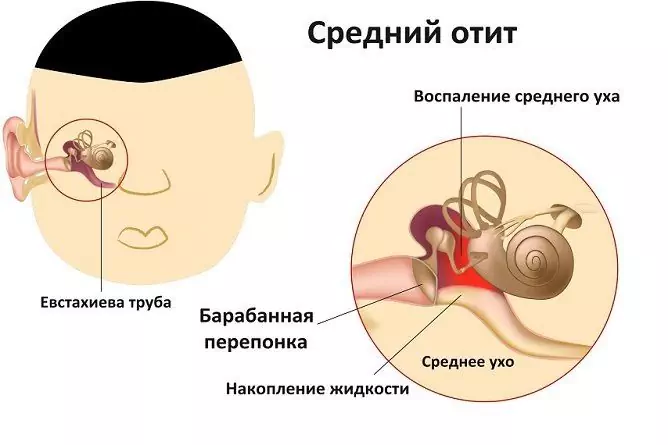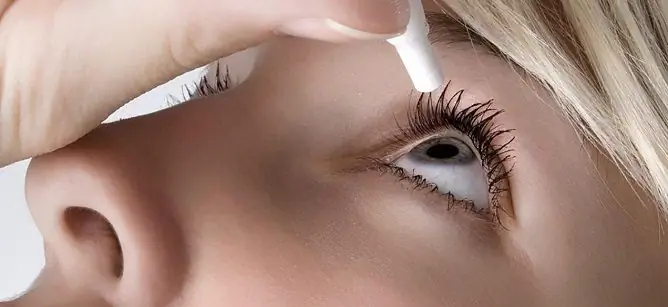Sofradex
Sofradex: instructions for use and reviews
- 1. Release form and composition
- 2. Pharmacological properties
- 3. Indications for use
- 4. Contraindications
- 5. Method of application and dosage
- 6. Side effects
- 7. Overdose
- 8. Special instructions
- 9. Application during pregnancy and lactation
- 10. Use in childhood
- 11. Drug interactions
- 12. Analogs
- 13. Terms and conditions of storage
- 14. Terms of dispensing from pharmacies
- 15. Reviews
- 16. Price in pharmacies
Latin name: Sofradex
ATX code: S01CA01
Active ingredient: Gramicidin C (Gramicidin S) + Dexamethasone (Dexamethasone) + Framycetin (Framycetin)
Manufacturer: Aventis Pharma, Ltd. (Aventis Pharma, Ltd.) (India); Sanofi India Limited (India)
Description and photo updated: 2019-27-08
Prices in pharmacies: from 284 rubles.
Buy

Sofradex is a drug with anti-inflammatory and antibacterial action for local use in ENT practice and ophthalmology.
Release form and composition
Dosage form - eye and ear drops: a transparent, almost colorless solution with the smell of phenylethyl alcohol (5 ml each in yellow transparent glass bottles, in a cardboard box 1 bottle complete with a dropper and instructions for the use of Sofradex).
Active substances in 1 ml drops:
- framycetin sulfate - 5 mg;
- dexamethasone (in the form of sodium metasulfobenzoate) - 0.5 mg;
- gramicidin - 0.05 mg.
Auxiliary components: phenylethanol (phenylethyl alcohol), sodium citrate, polysorbate 80, lithium chloride, ethanol 99.5%, citric acid monohydrate, water for injection.
Pharmacological properties
Pharmacodynamics
The action of Sofradex is due to the properties of its active ingredients.
Framycetin sulfate is an antibiotic from the aminoglycoside group that has a bactericidal effect. It has a wide spectrum of antibacterial action, is active against gram-positive microorganisms (including Staphylococcus aureus) and most clinically significant gram-negative microorganisms (including Escherichia coli, dysentery bacillus, Proteus, etc.). It is ineffective against streptococci. It has no effect on viruses, pathogenic fungi and anaerobic flora. The resistance of microorganisms to the action of the substance develops slowly.
Gramicidin has a bacteriostatic and bactericidal effect. Thanks to this component, the spectrum of antimicrobial action of framycetin expands (due to the activity of gramicidin in relation to staphylococci).
Dexamethasone is a glucocorticosteroid. It has a pronounced anti-inflammatory, desensitizing and anti-allergic effect. Suppresses inflammatory processes, which occurs due to the suppression of the release of inflammatory mediators, the migration of mast cells and a decrease in capillary permeability. When instilled in the eyes, it helps to reduce the severity of pain, burning, lacrimation, photophobia. When instilled into the ears, it reduces the manifestations of symptoms of otitis media (in the form of skin redness, pain, itching, burning sensation in the external auditory canal, feeling of ear congestion).
Pharmacokinetics
Systemic absorption of the active ingredients of Sofradex when applied topically is low.
Framycetin sulfate can be absorbed through open wounds or inflamed skin. Upon entering the systemic circulation, the substance is rapidly excreted unchanged by the kidneys. T 1/2 (half-life) ranges from 2 to 3 hours.
Oral dexamethasone can be rapidly absorbed from the gastrointestinal tract. T 1/2 of the substance is 190 minutes.
Indications for use
As eye drops, Sofradex is used to treat bacterial diseases of the anterior segment of the eye, such as:
- keratitis (without damage to the epithelium);
- conjunctivitis;
- sclerites and episclerites;
- blepharitis;
- iridocyclitis.
As ear drops, Sofradex is used in the following cases:
- otitis media of the outer ear;
- infected eczema of the skin of the eyelids.
Contraindications
- thinning of the sclera;
- violation of the integrity of the corneal epithelium;
- glaucoma;
- herpetic keratitis (treelike corneal ulcer);
- viral or fungal infections, trachoma, purulent inflammation of the eyes, tuberculosis;
- perforation of the tympanic membrane;
- infancy;
- During pregnancy and breastfeeding;
- hypersensitivity to drug components.
With caution, Sofradex eye and ear drops, especially in large doses and for a long time, should be used in the treatment of young children (due to the risk of suppression of adrenal function and the development of systemic side effects).
Sofradex, instructions for use: method and dosage
Eye diseases
The drug should be instilled into the conjunctival sac of the affected eye, 1-2 drops: with a mild course of an infectious disease - every 4 hours, with a severe infectious process - every hour, then gradually, as the inflammation decreases, the frequency of instillations should be reduced.
Ear diseases
The drug should be instilled into the external auditory canal 2-3 drops 3-4 times a day. You can also put a gauze swab moistened with a solution into the ear canal.
The duration of treatment with Sofradex eye drops should not exceed seven days.
Side effects
With prolonged use of the drug, the following side effects are possible due to the local corticosteroid dexamethasone:
- thinning of the cornea or sclera, which can lead to perforation;
- development of posterior subcapsular cataract (especially with frequent instillations);
- increased intraocular pressure with the development of a symptom complex of glaucoma (decreased visual acuity, damage to the optic nerve, the appearance of visual field defects);
- accession of a secondary infection (fungal).
In some cases, allergic reactions (usually of a delayed type) are noted: irritation, pain, itching, burning, dermatitis.
Overdose
If the contents of one bottle of Sofradex (up to 10 ml) are swallowed, serious adverse reactions are unlikely to occur.
With intensive and prolonged local use, systemic effects may develop.
Therapy: symptomatic.
special instructions
With long-term treatment, there is a possibility of developing superinfection caused by microorganisms resistant to Sofradex, including fungi.
With prolonged (more than seven days) and repeated therapy, it is necessary to regularly monitor intraocular pressure, as well as conduct an eye examination for the development of secondary infections and cataracts.
The drug should not be used in patients with eye hyperemia of unknown etiology, since this is fraught with significant visual impairment.
Framycetin sulfate, which is part of Sofradex, is an antibacterial agent from the aminoglycoside group, which is characterized by the development of oto- and nephrotoxic effects when used systemically and applied topically to damaged skin or open wounds. These effects are dose-dependent and intensify in hepatic and renal failure. And although such effects were not observed when the drug was instilled into the eyes, the likelihood of their development in children should be taken into account if the drug was used in high doses.
During instillation, care must be taken not to touch the tip of the pipette to the eye.
Influence on the ability to drive vehicles and complex mechanisms
After instillation of the drug in the eyes, a temporary decrease in the clarity of visual perception is possible, therefore, immediately after instillation, it is recommended to refrain from driving and working with complex mechanisms.
Application during pregnancy and lactation
Sofradex is not prescribed during pregnancy / lactation.
Pediatric use
- infants: therapy is contraindicated;
- young children: use Sofradex with caution.
Drug interactions
During treatment with Sofradex, other antibiotics with oto- and nephrotoxic effects (kanamycin, monomycin, gentamicin, streptomycin) should not be used.
Analogs
The analogues of Sofradex are: Tobrazon, DexaTobropt, Tobradex, Deksona, Maxitrol.
Terms and conditions of storage
Store at temperatures up to 25 ° C out of reach of children.
Shelf life - 2 years, after the first opening of the bottle - 1 month.
Terms of dispensing from pharmacies
Dispensed by prescription.
Reviews about Sofradex
Most of the reviews about Sofradex indicate its high efficiency. The advantages include the rapid development of the therapeutic effect, the convenience of the dispenser. When using the drug to treat the eyes, many users report that the drops cause a burning sensation. Among the shortcomings, they point to high cost, short shelf life after opening the package, and a pungent smell. There are practically no reviews about the development of serious side effects.
The price of Sofradex in pharmacies
The approximate price for Sofradex (5 ml bottle) is 290–372 rubles.
Sofradex: prices in online pharmacies
|
Drug name Price Pharmacy |
|
Sofradex (eye and ear drops) eye and ear drops 5 ml 1 pc. 284 r Buy |
|
Reviews Sofradex (eye and ear drops) 284 r Buy |
|
Sofradex eye drops and ear drops. 5ml (complete with dropper) 342 r Buy |

Maria Kulkes Medical journalist About the author
Education: First Moscow State Medical University named after I. M. Sechenov, specialty "General Medicine".
Information about the drug is generalized, provided for informational purposes only and does not replace the official instructions. Self-medication is hazardous to health!







